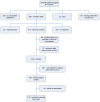Independent validation of an existing model enables prediction of hearing loss after childhood bacterial meningitis
- PMID: 23536814
- PMCID: PMC3594173
- DOI: 10.1371/journal.pone.0058707
Independent validation of an existing model enables prediction of hearing loss after childhood bacterial meningitis
Abstract
Objective: This study aimed external validation of a formerly developed prediction model identifying children at risk for hearing loss after bacterial meningitis (BM). Independent risk factors included in the model are: duration of symptoms prior to admission, petechiae, cerebral spinal fluid (CSF) glucose level, Streptococcus pneumoniae and ataxia. Validation helps to evaluate whether the model has potential in clinical practice.
Study design: 116 Dutch school-age BM survivors were included in the validation cohort and screened for sensorineural hearing loss (>25 dB). Risk factors were obtained from medical records. The model was applied to the validation cohort and its performance was compared with the development cohort. Validation was performed by application of the model on the validation cohort and by assessment of discrimination and goodness of fit. Calibration was evaluated by testing deviations in intercept and slope. Multiple imputation techniques were used to deal with missing values.
Results: Risk factors were distributed equally between both cohorts. Discriminative ability (Area Under the Curve, AUC) of the model was 0.84 in the development and 0.78 in the validation cohort. Hosmer-Lemeshow test for goodness of fit was not significant in the validation cohort, implying good fit concerning the similarity of expected and observed cases. There were no significant differences in calibration slope and intercept. Sensitivity and negative predicted value were high, while specificity and positive predicted value were low which is comparable with findings in the development cohort.
Conclusions: Performance of the model remained good in the validation cohort. This prediction model might be used as a screening tool and can help to identify those children that need special attention and a long follow-up period or more frequent auditory testing.
Conflict of interest statement
Figures
Similar articles
-
Addition of host genetic variants in a prediction rule for post meningitis hearing loss in childhood: a model updating study.BMC Infect Dis. 2013 Jul 23;13:340. doi: 10.1186/1471-2334-13-340. BMC Infect Dis. 2013. PMID: 23879305 Free PMC article.
-
Unsuccessful validation of 2004 model for predicting academic or behavioural limitations after childhood bacterial meningitis.Acta Paediatr. 2013 Dec;102(12):e553-9. doi: 10.1111/apa.12407. Epub 2013 Sep 21. Acta Paediatr. 2013. PMID: 24033640
-
Hearing loss at school age in survivors of bacterial meningitis: assessment, incidence, and prediction.Pediatrics. 2003 Nov;112(5):1049-53. doi: 10.1542/peds.112.5.1049. Pediatrics. 2003. PMID: 14595044
-
Risk scores for outcome in bacterial meningitis: Systematic review and external validation study.J Infect. 2016 Nov;73(5):393-401. doi: 10.1016/j.jinf.2016.08.003. Epub 2016 Aug 9. J Infect. 2016. PMID: 27519619 Review.
-
Does this child have bacterial meningitis? A systematic review of clinical prediction rules for children with suspected bacterial meningitis.J Emerg Med. 2013 Oct;45(4):508-19. doi: 10.1016/j.jemermed.2013.03.042. Epub 2013 Aug 2. J Emerg Med. 2013. PMID: 23910166 Review.
Cited by
-
Risk factors for infant hearing loss: a meta-analysis.Eur J Pediatr. 2024 May;183(5):2401-2409. doi: 10.1007/s00431-024-05498-3. Epub 2024 Mar 8. Eur J Pediatr. 2024. PMID: 38456989
-
Single nucleotide polymorphisms in pathogen recognition receptor genes are associated with susceptibility to meningococcal meningitis in a pediatric cohort.PLoS One. 2013 May 14;8(5):e64252. doi: 10.1371/journal.pone.0064252. Print 2013. PLoS One. 2013. PMID: 23691182 Free PMC article.
-
Study protocol: The Dutch 20|30 Postmeningitis study: a cross-sectional follow-up of two historical childhood bacterial meningitis cohorts on long-term outcomes.BMC Pediatr. 2019 Dec 30;19(1):519. doi: 10.1186/s12887-019-1900-1. BMC Pediatr. 2019. PMID: 31888554 Free PMC article.
-
Toll-like receptor 9 polymorphisms are associated with severity variables in a cohort of meningococcal meningitis survivors.BMC Infect Dis. 2012 May 11;12:112. doi: 10.1186/1471-2334-12-112. BMC Infect Dis. 2012. PMID: 22577991 Free PMC article.
-
Addition of host genetic variants in a prediction rule for post meningitis hearing loss in childhood: a model updating study.BMC Infect Dis. 2013 Jul 23;13:340. doi: 10.1186/1471-2334-13-340. BMC Infect Dis. 2013. PMID: 23879305 Free PMC article.
References
-
- McIntyre PB, O'Brien KL, Greenwood B, van de Beek D (2012) Effect of vaccines on bacterial meningitis worldwide. Lancet 380: 1703–1711. - PubMed
-
- Organization WH (2008) The global burden of disease: 2004 update. Geneva: Department of Health Statistics and Informatics in the Information, Evidence and Research Cluster of WHO.
-
- Fortnum H, Davis A (1993) Hearing impairment in children after bacterial meningitis: incidence and resource implications. Br J Audiol 27: 43–52. - PubMed
-
- Baraff LJ, Lee SI, Schriger DL (1993) Outcomes of bacterial meningitis in children: a meta-analysis. Pediatr Infect Dis J 12: 389–394. - PubMed
-
- Husain E, Chawla R, Dobson S, Dele Davies H (2006) Epidemiology and outcome of bacterial meningitis in Canadian children: 1998–1999. Clin Invest Med 29: 131–135. - PubMed
MeSH terms
Grants and funding
LinkOut - more resources
Full Text Sources
Other Literature Sources
Miscellaneous



